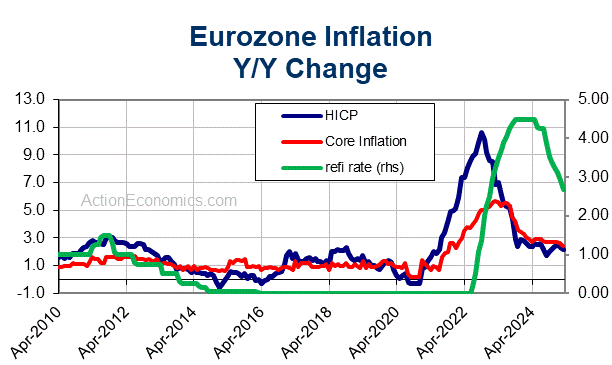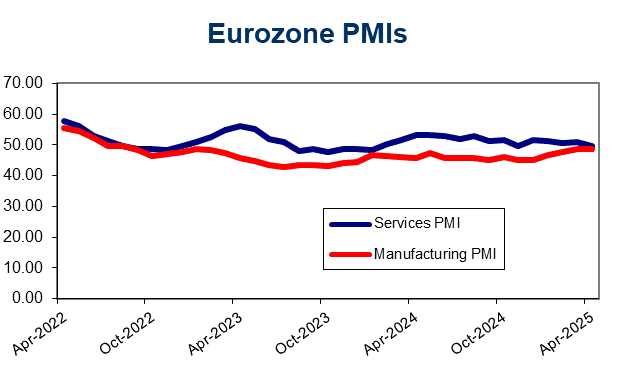ECB officials continue to dampen rate cut speculation, following on from Lagarde’s hawkish comments yesterday. Officials have been out in force this morning to continue stressing that the inflation outlook remains uncertain and that the central bank is not committing to a particular rate path for the rest of the year.
The ECB cut rates by 25 basis points, but as we expected it was a “hawkish” cut that left all options open for the second half of the year. Lagarde repeatedly stressed that future decisions will be data dependent, and even refused to confirm that yesterday’s move was the first step of an easing cycle. Rate cuts in September and December are still a possibility, but not cast in stone.
Simkus admitted that there may be more than one rate cut this year, but on the whole, the comments were designed to keep a lid on speculation that the central bank kicked off a rate cut cycle yesterday. Austria’s central bank head Holzmann went on record yesterday to confirm that he was the sole dissenter objecting to a cut yesterday, and so far the doves have been quiet, which is helping to affirm Lagarde’s hawkish message yesterday.
Details of the Rate Cut
The ECB delivered the first rate cut in five years and lowered key rates by 25 basis points. The deposit rate is now at 3.75% and the main refinancing rate at 4.25%. It was a “hawkish cut,” as near term inflation forecasts were revised higher, and Lagarde flagged that domestic inflation remains high. The statement stressed that the ECB is not pre-committing to a particular rate path, and the comments leave all options on the table for the second half of the year.
Economic Activity and Forecasts
The ECB noted the improvement in economic activity through the first quarter of the year. Lagarde also highlighted that manufacturing is showing signs of stabilization, with stronger exports expected to support growth in coming quarters. At the same time, monetary policy should be less of a drag on demand over time, according to the ECB. The new set of forecasts show GDP rising 0.9% this year, which is more than the 0.6% expected back in March. The forecast for 2025 has been revised slightly down to 1.4% from 1.5% previously, and the ECB still expects a slight acceleration to 1.6% for 2026.
The inflation forecast for this year was raised to 2.5% from 2.3%, and the projection for 2025 was hiked to 2.2% from 2.0%. As such, inflation will fall toward the target later than previously anticipated, though the forecast for 2026 was left unchanged at 1.9%. This means the headline rate is still expected to fall below the target at the end of the forecast horizon.
Upside Risks to Inflation
The statement noted upside risks to the inflation outlook from wages and profits, which could be higher than currently anticipated. Geopolitical tensions and extreme weather events could also push up prices once again, according to the ECB. At the same time, the ECB acknowledged that inflation could come in lower than anticipated if monetary restrictions have more of a dampening effect than currently anticipated, or if global growth weakens more than projected.

The press conference was mainly dedicated to driving home the point that future decisions will depend on data available at the time of the respective meeting. Lagarde even refused to confirm that the central bank has effectively kicked off an easing cycle, and said in response to a question that she wouldn’t necessarily say that the ECB started a “dialing-back process”. She suggested it is likely, but refused to confirm it, which in theory means rates could actually go up again.
This seems unlikely, given that this move was a near unanimous decision, but its makes clear that the ECB will not cut rates at every meeting and that the outlook for the rest of the year is still very much open. The ECB still thinks that monetary policy needs to remain restrictive for the foreseeable future against the backdrop of high domestic inflation. However, as chief economist Lane suggested recently, officials will have to debate at every meeting whether the data allows the central bank to dial back the degree of restrictiveness.
Employment and Inflation Dynamics

Wage growth, profits, and services price inflation will remain the key numbers to watch through the rest of the year. Lagarde pointed to data on the compensation of employees, due to be released tomorrow, but also flagged that current wage agreements are often still backward looking, as they reflect attempts to compensate for the sharp rise in prices since the start of the Ukraine war. As we flagged previously, the multi-year wage agreements in Germany are a prime example of that. However, as Lagarde highlighted, the deals on the table so far show sharp increases for this year, but also imply a slowdown in wage growth in coming years.
However, unemployment is at a record low and the number of vacancies has dropped only slightly. At the same time, service price inflation remains stubbornly high, which suggests that companies have sufficient room to pass on higher labor costs. With real disposable income rising, thanks to lower inflation and higher wages, companies could find it even easier to hike prices in the second half of the year, and yesterday’s rate cut is also likely to boost demand. In the current situation, this could add to domestic price pressures.
Looking ahead, the only thing that is clear is that Lagarde did her best to keep expectations of back-to-back cuts under control. The chances still are that the ECB will deliver two more 25 basis point cuts in September and December, but at this point, nothing is cast in stone.
Click here to access our Economic Calendar
Andria Pichidi
Market Analyst
Disclaimer: This material is provided as a general marketing communication for information purposes only and does not constitute an independent investment research. Nothing in this communication contains, or should be considered as containing, an investment advice or an investment recommendation or a solicitation for the purpose of buying or selling of any financial instrument. All information provided is gathered from reputable sources and any information containing an indication of past performance is not a guarantee or reliable indicator of future performance. Users acknowledge that any investment in Leveraged Products is characterized by a certain degree of uncertainty and that any investment of this nature involves a high level of risk for which the users are solely responsible and liable. We assume no liability for any loss arising from any investment made based on the information provided in this communication. This communication must not be reproduced or further distributed without our prior written permission.



















